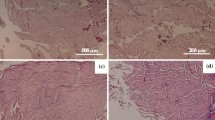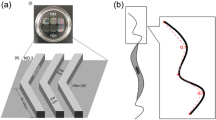Multiple grooved substrata with groove depth 5 μm were found to facilitate the healing of completely divided rat flexor tendons in vitro. Sections of tendons cultured on plain substrata showed only partial healing with incompletely sealed epitenon layers and immature thin collagen fibres. Tendons cultured on patterned substrata healed with complete restoration of the epitenon layer and reconstitution of the internal structure of collagen fibres. Epitenon fibroblasts isolated from the surface of rat flexor tendons were shown to be more sensitive to topographical features than fibroblasts of the same size BHK fibroblasts. They remained more elongated and better aligned to the groove direction than BHK cells. Multiple grooved substrata facilitated epitenon cell movement. Cells were found to move with higher speed on patterned substrata than on plain substrata. In summary, we conclude that the use of multiple grooved substrata promotes tendon healing in vitro and may find application in clinical practice in tendon repair.
Similar content being viewed by others
References
W. K.Linsday and H. G.Thomson, Brit. J. Plast. Surg. 12 (1961) 289.
D. M.Rothkopf, S.Webb and R. M.Szabo, J. Hand. Surg. 16A (1991) 694.
A. S. G.Curtis and P.Clark, Critical Reviews in Biocompatibility 5 (1990) 343.
P.Clark, P.Connolly, A. S. G.Curtis, J. A. T.Dow and C. D. W.Wilkinson, Development 108 (1990) 635.
D. M.Brunette, Expl. Cell Res. 167 (1986) 203.
D. M.Brunette, Expl. Cell Res. 164 (1986) 11.
I.Nagata, A.Kawana and N.Nakatsuji, Development 117 (1993) 401.
T.Morikawa, Y.Odagawa, K.Keino and J.Fukuda, Neurosci. Lett. 127 (1991) 16.
G. A.Dunn and A. F.Brown, J. Cell Sci. 83 (1986) 313.
A.Wood, J. Cell Sci. 90 (1988) 667.
P. T.Ohara and R. C.Buck, Expl. Cell. Res. 121 (1979) 235.
A. S. G.Curtis and M.Varde, J. Natl. Cancer Inst. 33 (1964) 15.
D. M.Brunette, G. S.Kenner and T. R. L.GouldJ. J. Dent. Res. 62 (1983) 1045.
P.Weiss, J. Exp. Zool. 69 (1934) 393.
P.Weiss, J. Exp. Zool. 100 (1945) 353.
L.Loeb and M. S.Fleisher, J. Med. Res. 37 (1917) 75.
J. E.Aaron and D. H.Carter, J. Histochem. Cytochem. 35 (1987) 361.
B.Wòjciak and J. F.Crossan, Clin. Exp. Immunol 93 (1993) 108.
Author information
Authors and Affiliations
Rights and permissions
About this article
Cite this article
Wòjciak, B., Crossan, J., Curtis, A.S.G. et al. Grooved substrata facilitate in vitro healing of completely divided flexor tendons. J Mater Sci: Mater Med 6, 266–271 (1995). https://doi.org/10.1007/BF00120269
Received:
Accepted:
Issue Date:
DOI: https://doi.org/10.1007/BF00120269




